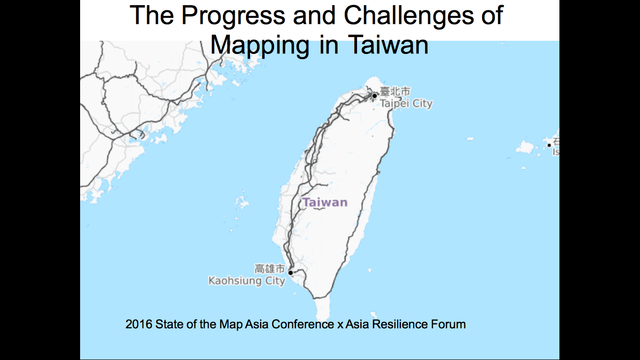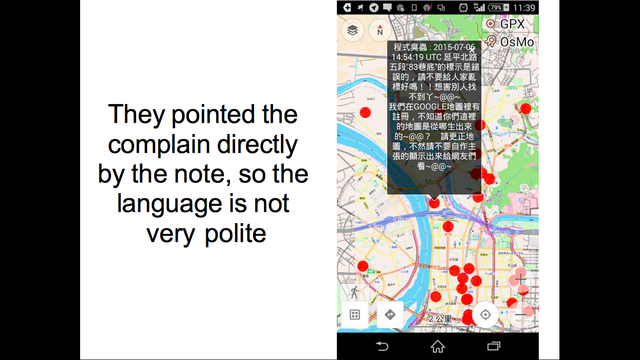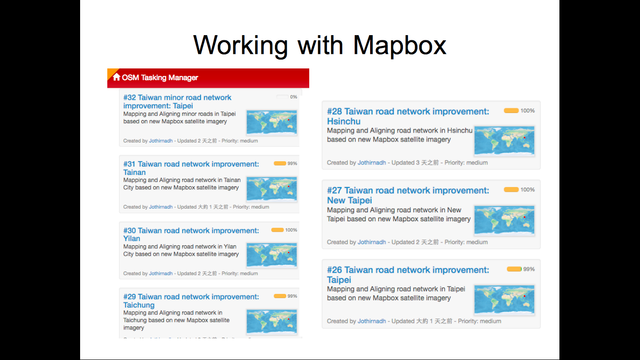My Talk about Taiwan Related Localizated Tagging Scheme Proposed and the Experience of State of the Map Asia
Posted by Supaplex on 22 November 2016 in English. Last updated on 26 November 2016.It is rush decision for me to decide to go to Manila for attending State of the Map Asia. I saw there is a scholarship I could apply, so I want to talk about the situation of Taiwan community, and meet some OpenStreetMap-related company. I’m very glad I travel to the Philippine, meet some old friend like Wular, and meet the Mapbox data team in India.
Also I meet the famous Manning from the Philippine community. Mapbox team recently are relining Taiwan road network, using the new arrived Mapbox satellite image, and Strava GPS trace. I met these guys only online, finally I have a change to talk with them face-to-face, and thank them of their hard work. We discussed what is the situation in Taiwan, what we local community can do to help them.

Here is my talk slide. Due to the limit time, I decrease the size of my slide and skip some event. In the following post here, I’ll describe what I told during my presentation, and keep a written record.

What did Facebook effect Taiwan when using OSM data
I didn’t describe well about the Facebook part, there are some people discuss of what Facebook actually do after my talk. I didn’t make it about the two things Facebook do: 1 training AI to map; 2 using OSM-based map on landmark page.

I think who is familiar with OSM and knows about OSM-related issue will learn about the first one. They knows about Facebook AI made a mistake which draw the road network again in the Egypt case, I will not write about it here due to the limit article here.
Facebook use OSM as base map on landmark page both in Japan and South Korea. The landmark data is on the hand of Facebook, and mostly are Facebook users submitted. The switch made a big wind in Taiwan. One reason is not every alley in the effect area is mapped, some people saw the not well mapped map feel it is not a good one. The other reason is most people don’t know that the location of landmark is user-submitted. If one person mark the wrong location, then the data on Face will be wrong. One see the wrong landmark information and the not so detailed basemap. OSM is blamed for the wrong doing, but it’s not the issue of OSM. The wrong location of landmark is an issue of Facebook.
The most exaggerated example is someone report his landmark location is wrong, and also blame the alley around his store is missed. And his usage of language is not very polite. When the user submitted response by the note report system direct from Facebook, small and serious complain rush in. Some are OSM problems, and some are Facebook problems, like the landmark location is wrong. There response including the one not so polite, did not know the response is public available, will be on the internet permanently.

Finally Facebook was annoyed, didn’t have enough manpower to handle the complains they should handle. The basemap of Taiwan landmark pages switch to Here map, and terminate the issue for OpenStreetMap Taiwan community.
The multi-language proposed from a Chinese language user from Taiwanese
It is said that OSM could make multi-language map possible, handling the different needs of different language users need. Despite the name field for common name used by the local, we see the name filed of name:en, name:de, name:ja, name:fr, name:zh for different corresponding language name, using the alpha-2 code of ISO 639-1 name code suffix.
Although there is a possibility for multi-language name tagging on OSM, the scheme standard should be discussed first. In the current OSM tagging scheme, the use of name:zh for Chinese language is not enough, not covering the people using Traditional and Simplified Chinese. There should be tagging scheme for Traditional Chinese and Simplified Chinese correspondingly.
And there is a big problems, for the area using Chinese like China and Taiwan, which one Chinese is Chinese, could use the name:zh field, the Chinese used in Taiwan, or the Chinese used in China? Which one Chinese is Chinese?
So the OpenStreetMap Taiwan community member Rex draw up the language name tag according to IETF language tag (BCP 47). The draft including the area using Chinese, like Taiwan, China, Hong Kong, and Macau.

For Taiwan and China, using Traditional and Simplified Chinese separately, using the corresponded Chinese in name:zh field is not a problem. But for area outside these Chinese using area, the Chinese name of some place are totally different, not just the different of Traditional and Simplified Chinese characters. For example Mt. Everest, the name in Taiwan Chinese is 聖母峰(Shengmu Feng, literally means Holy Mother Peak), the name in China Chinese is 珠穆朗玛峰(Chomolungma).
It seems that Mr. Everest is far away for the Filipinos, the response was not strong during my talk. I should use the well known Filipino names or tourist attraction, like Mindanao or Bohol. These two places name in Taiwan and China Chinese:
- English Taiwan Traditional Chinese China Simplified Chinese
- Mindanao 民答那峨 棉兰老
- Bohol 薄荷 保和
This shows that despite the different character set of Taiwan and China, there is also different in customs translating terms, will effect the OSM localization and user experience.
Despite the Chinese name scheme, the draft will also deal with the name scheme of Formosa Language used Taiwan Aboriginal, which belongs to Austronesian language family. When OSM spreed in Taiwan, there was discussion about the Taiwan Aboriginal language prefix, also including in the draft.

In the long term for the OpenStreetMap Taiwan community, we wish the developer using OSM data could progressively adapt the name scheme dealing with the different Chinese use case. And finally it could fix the different Chinese character and terms issues. Bringing more customized and localized user experience for different users. When the OpenStreetMap Taiwan community finalize the draft into a standard scheme, we might notify map app developer who use OSM data, wish them adapt for the scheme.
The tagging of place of worship is totally different from Europe and America mainstream religion
For the religion tag use now, there are different tag use for Buddhism, Christian, Cathedral, Taoism, and Muslim. But the religion tags do not represent Taiwan religion and folklore religion very well. The standard makes confusing. There are very temple in Taiwan are mainly focus on historical figures, so distinguish they belong to different religion do not make sense at all. It should focus more on which deity the place is worshiped.
When I was young I learned that using the last word of a temple to distinguish the temple is a Buddhism or Taoism place, the xx 宮 is a Taoism temple, and the xx寺 is a Buddhism temple. I used this standard to tag temple for awhile. But studying the religious issue in Taiwan, I found out that is not very precisely. It is more accurate and making sense to distinguish by the main deity in the place of worship worshiped.

So Rex proposed the draft for the traditional Taiwan forklore religion scheme. By proposing a new draft standard for the face of multivariate Taiwan religion and denomination, we could fix the issue we talk about, and fix the different and disorder standard use currently in OSM. Despite we should distinguish by the main deity in the temple, we should independently draft a new Taiwan traditional folklore religion tag. We have an example to explain below:
Traditional Han people religion:
- religion=folk
- denomination=TaiwaneseFolkReligion
For non-Han people religion, like Siraya people Aritt’s Kuwa:
- religion=folk
- denomination=SirayaFolkReligion
The temple tagging example:
Tzihua Temple (should be tag according to the operating mode of the temple) * religion=folk * denomination=TaiwaneseFolkReligion * dedication:principal=瑤池金母 * dedication:principal:wikidata=Q1064059
Another tagging problem
There are another problem like the iD interface for address field, will be fix when the release of iD 2.0. When the iD was release, the address field is in English address mode, not suitable for Chinese address.
I mentioned Mapbox team relining Taiwan road network according to the data of Strava GPS trace and the new Mapbox Satellite image. I talked with the Mapbox team very deeply. We met first on the online platform, discussing about how to handle Taiwan road network. It was a very unique experience for me to meet the web pal on line, just like meet someone face-to-face I know online for the first time.

I also had a chance to meet Maps.me CEO Eugene, and exchange view about OSM. When his talk, he mentioned OSM needs light contributor, to bring more local information like stores. So there is a need for an App that could add information very easy. I told him there was very unique way from a Maps.me user: despite adding store name, he also added $ symbol for the price range, \(\) for very expensive, and $ for very cheap. I have to say that the price range is very important information, but how to handle in OSM database is a problem.

Eugene said in the future release of Maps.me app, they will add a function to edit the road name. It is a very important information for the local and big crowd of Maps.me user, and they can add the basic and fundamental information. I agree with his point about the importance of adding road name.
Looking forward for the conference in Nepal
Nama said he was annoyed by everyone ask him about the Nepal earthquake experience. He kept invite to talk about the crisis mapping in Nepal earthquake, even this time of State of the Map Asia. It is time to record the experience by a conference in Nepal, otherwise it will be forgotten. Another factor is many important figures could make it very easy to talk about the experience aboard. The next year 2017, there is a high possible of State of the Map Asia hold in Nepal. Nama said he will invite everybody for the conference, and could arrange climbing Himalaya mountain.

Although it is just a 2 hours flight, most Taiwanese won’t head south. Most Taiwanese will choose to flight North to more familiar Japan. If the conference organizer not invite me this time, I would not travel south to the neighborhood country the Philippine. Despite the experience to talk with other attendees, I also had a deep experience of the local Philippine culture. I’m very appricate of the arrangement from the organizers, and very happy to share my experience of Taiwan community.
Discussion
Comment from PlaneMad on 23 November 2016 at 10:16
Excellent writeup highlighting the cultural data issues on temples and language tags on the map. A possible solution to the Chinese labels is to use more granular tag variations like Wikidata does, and maybe try to ultimately have the various translations in Wikidata itself.
The FB incident is interesting, did they allow users to edit/improve OSM from FB?
Comment from Supaplex on 26 November 2016 at 09:15
Hi PlaneMad,
About the Facebook involved in OSM, they let Facebook user to report error using the OSM note system. But they don’t direct Facebook user to edit OSM.
For WIkipedia way of distinguish different Chinese used in different area, the writing is more simple, but for the different Chinese language or dialect, it’s more complicated. So there is a different approach than Wikipedia.